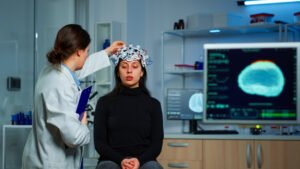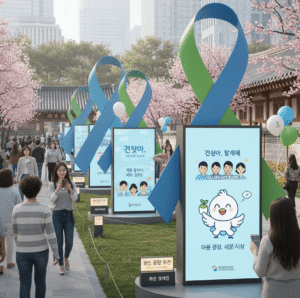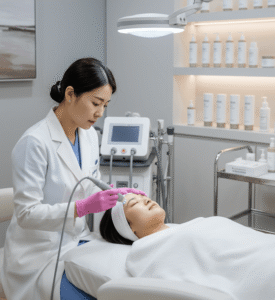Overview
Blurred vision is a common visual disturbance where objects appear out of focus, hazy, or indistinct. It can affect one or both eyes, occur suddenly or gradually, and may involve near or distance vision. While occasional blurred vision may result from temporary eye strain, persistent or recurrent episodes often signal underlying eye or systemic conditions that require medical attention.
In South Korea, ophthalmology clinics and specialized eye hospitals provide advanced diagnostic services, treatments, and preventive care for patients experiencing blurred vision, ensuring early detection and management of potential eye or systemic diseases.
Key Facts
Highlights:
➡️ Blurred vision can be temporary or chronic, depending on the cause.
➡️ One-eye blurring may indicate localized eye issues; both eyes affected often point to systemic or refractive causes.
➡️ Common triggers include refractive errors, eye strain, infections, or systemic diseases such as diabetes or hypertension.
➡️ Blurred vision may accompany other symptoms like headache, eye pain, or light sensitivity.
➡️ South Korea offers comprehensive eye exams, imaging, and treatment for underlying causes of blurred vision.
What is Blurred Vision?
Blurred vision is the inability to see fine details clearly, caused by disturbances in the optical pathway of the eye.
Characteristics include:
- Objects appearing hazy, fuzzy, or out of focus
- Difficulty reading or recognizing faces
- Vision may fluctuate throughout the day
- Often accompanied by headaches, eye strain, or discomfort
- Can affect near, distance, or both fields of vision
Blurred vision is a symptom rather than a standalone disease, providing important clues about ocular or systemic health.
What Symptoms are Related to Blurred Vision?
Symptoms may vary depending on the underlying cause:
- Hazy or foggy vision
- Double vision or overlapping images in some cases
- Difficulty focusing on close or distant objects
- Eye strain, fatigue, or headaches
- Sensitivity to light (photophobia)
- Redness, itching, or watery eyes if associated with infections
- Floaters or flashes in cases of retinal issues
Highlights:
➡️ Blurred vision may be acute or chronic, intermittent, or constant.
➡️ Associated symptoms help identify the underlying cause and guide treatment.
What Causes / Possible Causes of Blurred Vision?
Highlights:
➡️ Refractive Errors: Nearsightedness (myopia), farsightedness (hyperopia), or astigmatism.
➡️ Cataracts: Clouding of the lens leading to gradual vision blur.
➡️ Glaucoma: Increased intraocular pressure affecting optic nerve function.
➡️ Macular Degeneration: Damage to the central retina causing distorted or blurry vision.
➡️ Diabetic Retinopathy: High blood sugar damages retinal blood vessels, leading to blurred vision.
➡️ Dry Eye Syndrome or Eye Strain: Reduced tear production or prolonged screen use can blur vision temporarily.
➡️ Infections or Inflammation: Conjunctivitis, uveitis, or keratitis may contribute.
➡️ Systemic Conditions: Diabetes, hypertension, migraine, or neurological disorders.
➡️ Medications: Certain drugs can affect visual clarity as a side effect.
When Should I See My Doctor?
Highlights:
➡️ If blurred vision appears suddenly, especially in one eye, as it may indicate retinal detachment, stroke, or acute glaucoma.
➡️ If accompanied by eye pain, redness, halos around lights, or headache.
➡️ If persistent or progressively worsening, even without pain, professional evaluation is necessary.
➡️ If associated with systemic symptoms, such as dizziness, weakness, or numbness, urgent assessment is required.
➡️ Early consultation prevents complications and facilitates timely treatment for underlying causes.
Care and Treatment
Management focuses on correcting vision and addressing underlying causes:
Highlights:
➡️ Refractive Correction: Prescription glasses, contact lenses, or refractive surgery for myopia, hyperopia, or astigmatism.
➡️ Medical Treatment: Eye drops for glaucoma, anti-inflammatory or antibiotic therapy for infections.
➡️ Surgical Options: Cataract removal, retinal surgery, or laser therapy for diabetic retinopathy.
➡️ Lifestyle and Eye Care: Reducing screen time, using proper lighting, and maintaining eye hygiene.
➡️ Systemic Disease Management: Control of blood sugar, blood pressure, or autoimmune conditions affecting the eyes.
➡️ Monitoring and Follow-Up: Regular eye exams to track progression and prevent vision loss.
➡️ Patient Education: Awareness of warning signs such as sudden vision changes or flashes of light.
Treatment Options in Korea
South Korea offers state-of-the-art ophthalmology and vision care for blurred vision:
Highlights:
➡️ Comprehensive Eye Clinics: Advanced diagnostics, OCT imaging, and visual field testing.
➡️ Laser and Surgical Centers: Cataract surgery, LASIK, and retinal interventions.
➡️ Specialized Diabetes and Hypertension Clinics: Address systemic causes of blurred vision.
➡️ Preventive Eye Care Programs: Regular screenings for children, adults, and seniors.
➡️ Advanced Medical Devices: Imaging and surgical equipment for precise diagnosis and treatment.
➡️ Multidisciplinary Approach: Collaboration between ophthalmologists, endocrinologists, and neurologists.
➡️ Medical Tourism Support: Structured consultations, multilingual services, and follow-up care for international patients.













